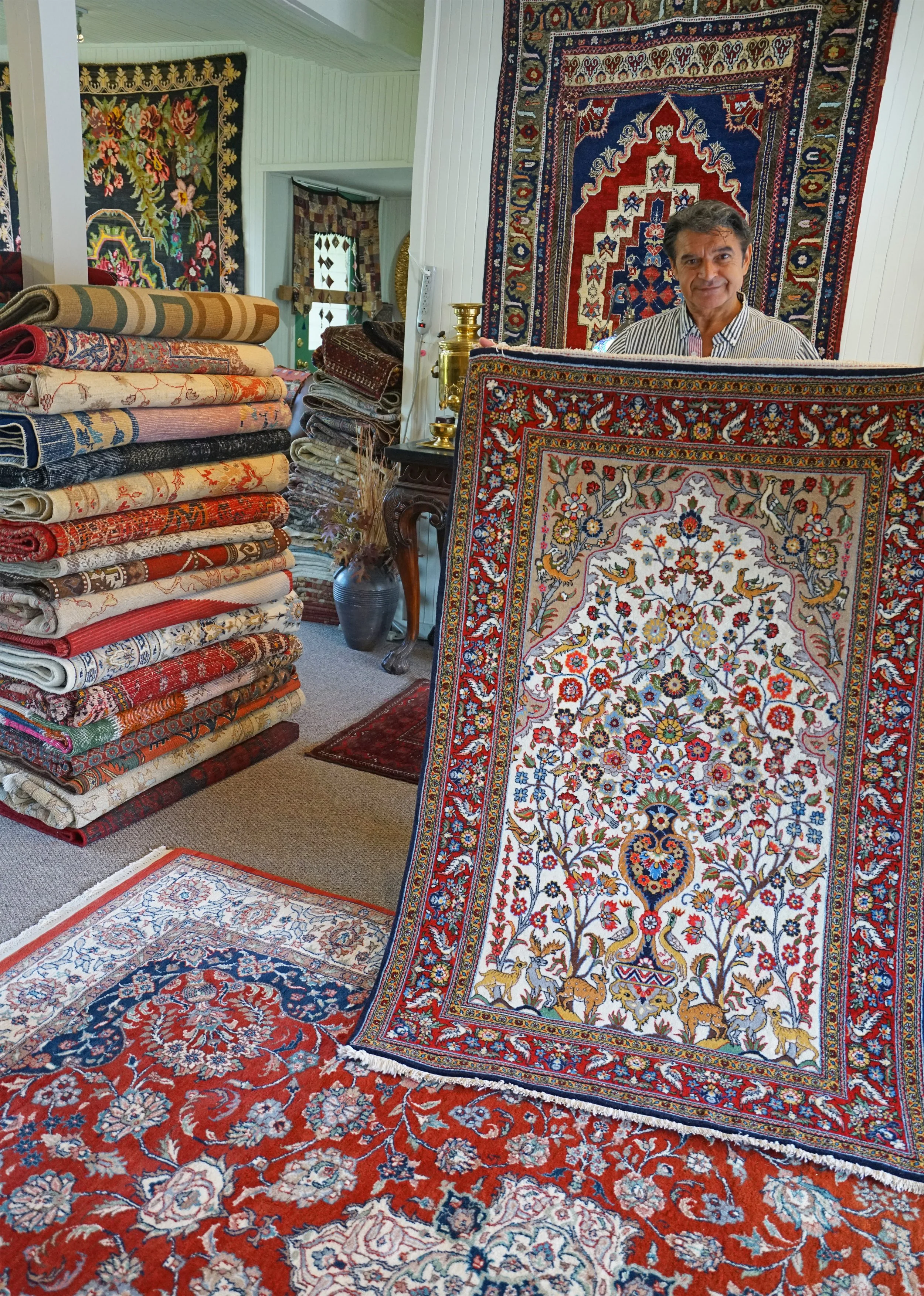Carpet diem
Seize the day with a visit to Cloverdale’s Istanbul Rug Bazaar
By Eliot Sekuler
For the TODAY
It’s a world away from the ancient passage known as the Silk Road, but on the stretch of Highway 101 passing through Cloverdale, carpet dealer Mehmet Sahin is maintaining a tradition that can be traced back to that legendary Central Asian trade route.
His shop is called Istanbul Rug Bazaar, Too and for Sahin, it represents a continuation of a business that has been part of his family’s livelihood for generations. The Turkish-born Sahin proudly considers that he’s helping to sustain an art form that goes back at least 2,500 years — a craft that has been perfected throughout the millennia in the far-flung farms and villages of central Asia.
Seated in his spacious store surrounded by stacks of neatly folded rugs, with colorful, intricately patterned hanging carpets lining the walls and others at his feet, Sahin spoke of his family’s age-old involvement in the carpet business.
“Everybody in our village had a loom in their home,” said the man whose family’s roots are in the small Kurdish town of Babik, in Turkey’s Southeastern Anatolia region. “It’s a farming area and in the winter, when there’s a lot of snow, people work on weaving the carpets. I have some rugs made by my mother and she had rugs made by her mother.”
Sahin’s grandfather supplemented the family’s farm income by taking carpets from Babik and surrounding villages to the great rug markets in the Istanbul bazaar, establishing the family’s business as rug merchants.
The Middle Eastern rugs displayed in the Cloverdale shop are all woven by hand on a loom, with warps, wefts and pile of wool, cotton and silk natural fibers. Many of the rugs Sahin sells originate in his homeland. Others come from the Caucasus Mountains, from Iran, Turkestan and Afghanistan.
Creation of the rugs is a multi-step process involving the spinning and dying of the wool, the designing of the pattern and the long process of hand-weaving. It can take months to complete a single rug, much longer for a large carpet.
None of Sahin’s carpets contain synthetic materials and no machines are used in their creation.
“All our rugs are hand-woven of pure, hand-spun wool, cotton or silk,” he said. “Each piece is authentic, an example of work from a specific region and none are imitations. As a result, each is a unique, one-of-a-kind collectible.”
Four basic types of rugs are produced in central Asia. Knotted “pile” rugs can be made using either the single knotted, Persian-style knot, also known as the senneh knot, or the double knotted Turkish style. Each has its advantages, and rug experts generally consider that the value of the carpet depends more on the weaver's skills, the intricacy of the design and the quality of the materials than on the type of knot that is used.
The store also carries traditional flat-woven rugs in two styles: kilims, which are often used as wall-hangings as well as floor coverings, and the highly prized embroidered soumaks, notable for their elaborate, intricately crafted designs.
The use of natural fibers — silk, cotton and, predominantly, wool — is key to the value and durability of the carpets.
“Natural dyes are used,” Sahin said “so the colors you see have variations made from elements found in nature, such as flowers, bark and plants.”
According to Sahin, pure wool rugs have important advantages over synthetics.
“They are easy to care for and don’t retain dirt as synthetics do,” he said. “When something drops on them, cold water will take it out 99 percent of the time. And when you shake the rugs out, they don’t keep the dirt inside. A handwoven rug made with natural dyes will last for generations. There’s no comparison between hand-woven and machine-made rugs.”
Sahin added that hand-woven rugs from Central Asia retain their value, since there’s an active market for antique and well-preserved used rugs. Their rarity and value is increasing as supplies diminish.
“The number of people who are making these beautiful rugs is decreasing every year,” he said. In contrast, machine-made rugs lose their value upon purchase. “People may pay a thousand dollars for a machine rug and if they want to sell it, there’s no market for it.”
Before opening the Cloverdale store, Sahin established his first US shop, Istanbul Rug Bazaar, in Northwest Portland. He maintained the store for 25 years before moving his business to the coast.
“I chose Cloverdale because I really love it here and it allows me to take a couple of months off each year to go on buying trips,” he said. “I travel back to Turkey and visit different villages. I like to give my appreciation to the people who put so much effort into the craft of rug making. When you tell the weavers how much their work is really appreciated, it’s a very special feeling.”
Istanbul Rug Bazaar, Too is located at 34390 Hwy. 101 in Cloverdale and is open Thursday through Sunday from 11 am to 4 pm and by appointment. For more information, call 971-266-9247.

